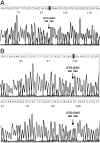BRAF mutations in aberrant crypt foci and hyperplastic polyposis
- PMID: 15793287
- PMCID: PMC1602378
- DOI: 10.1016/S0002-9440(10)62327-9
BRAF mutations in aberrant crypt foci and hyperplastic polyposis
Abstract
Patients with hyperplastic polyposis have multiple hyperplastic polyps (HPs) and increased risk of colorectal carcinomas. Aberrant crypt foci (ACF) are postulated to be the earliest precursor lesions in colorectal carcinogenesis. We evaluated BRAF mutations by DNA sequencing in 53 ACF from patients with sporadic colorectal carcinomas and familial adenomatous polyposis, in 18 sporadic HPs from patients with resected colorectal cancer, and in 70 HPs, 4 serrated adenomas, 3 admixed hyperplastic-adenomatous polyps, 10 tubular adenomas, and 6 carcinomas from 17 patients with multiple/large HPs and/or hyperplastic polyposis. BRAF mutation status was compared with clinicopathological features and other genetic alterations by marginal logistic regression. BRAF mutation was present in only 2% of ACF and 6% of sporadic HPs. In contrast, BRAF mutation was present in 43% of HPs (P = 0.01 versus sporadic HPs), 75% of serrated adenomas, 33% of admixed hyperplastic-adenomatous polyps, 30% of tubular adenomas, and 33% of carcinomas from patients with multiple/large HPs and/or hyperplastic polyposis. BRAF mutation status in patients with multiple/large HPs and/or hyperplastic polyposis correlated with HPs from the same patient (odds ratio, 5.8; P = 0.0002) but associated with younger age (odds ratio, 0.83; P = 0.006 compared to older age), with a large HP (odds ratio, 22.5; P = 0.01 compared with patients with multiple HPs), with location of HPs in the right colon (odds ratio, 3.0; P = 0.03), and with methylation of the p16 gene and the MINT31 locus [odds ratio, 12.2 (P = 0.0001) and 4.4 (P = 0.02), respectively]. Our study shows that BRAF mutation status is heterogeneous among patients with multiple/large HPs and/or hyperplastic polyposis, suggesting differences in pathogenesis of HPs that indicate subsets within this phenotype.
Figures


References
-
- Otori K, Oda Y, Sugiyama K, Hasebe T, Kinzler KW, Vogelstein B. Lessons from hereditary colorectal cancer. Cell. 1996;87:159–170. - PubMed
-
- Fearon ER, Dang CV. Cancer genetics: tumor suppressor meets oncogene. Curr Biol. 1999;9:R62–R65. - PubMed
-
- Chung DC. The genetic basis of colorectal cancer: insights into critical pathways of tumorigenesis. Gastroenterology. 2000;119:854–865. - PubMed
-
- Nucci MR, Robinson CR, Longo P, Campbell P, Hamilton SR. Phenotypic and genotypic characteristics of aberrant crypt foci in human colorectal mucosa. Hum Pathol. 1997;28:1396–1407. - PubMed
-
- Pretlow TP, Brasitus TA, Fulton NC, Cheyer C, Kaplan EL. K-ras mutations in putative preneoplastic lesions in human colon. J Natl Cancer Inst. 1993;85:2004–2007. - PubMed
Publication types
MeSH terms
Substances
LinkOut - more resources
Full Text Sources
Medical
Research Materials
Miscellaneous

